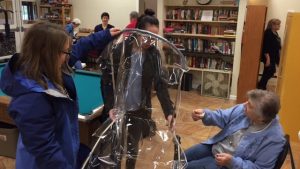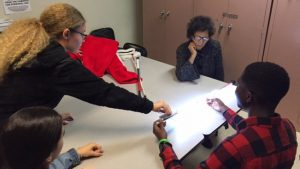Engineering students strive to improve personal care devices for locals
By Bryan Hay
Marie DuPont could barely contain her delight when Maddie Holden ’21 and Ashley Wilk ’21 revealed their design for a rain protector for her walker.
For DuPont, using a walker helps with mobility and preserves her independence, but leaving home with it on a sunny day has its consequences if a rainstorm flares up. Unfolding and holding an umbrella is challenging enough, but it doesn’t do anything to protect against rain-swept headwinds.
“You wake up and the sun is shining, but then it starts to rain, and there’s no protection against the rain coming in at you,” she says.
Students in Rachel Koh’s first-year mechanical engineering design class have been visiting clients at Easton Area Lifestyle Center in nearby Forks Township to gain an understanding of their needs and challenges and applying their engineering instincts and imaginations to help improve the lives of seniors. Lafayette students and faculty have worked with the center for decades to help support seniors in the Easton area.
 Holden and Wilk designed what they describe as a reverse baby carriage shield, which attaches with Velcro strips to the front of a walker and keeps the rain out of the user’s face.
Holden and Wilk designed what they describe as a reverse baby carriage shield, which attaches with Velcro strips to the front of a walker and keeps the rain out of the user’s face.
Their reveal on a recent visit was met with enthusiasm and a broad smile.
“Wow, just wow … very, very nice,” DuPont says. “I’m so proud of you and what you’ve done. I’m going to brag about you to my grandson. He’s a Lafayette grad.”
Koh, assistant professor of mechanical engineering, says mechanical engineering has played a significant role in the development of prosthetics for the military, and engineers also are making contributions toward designing and improving personal care devices.
While Koh’s students are focusing on design principles in their interactions at Easton Area Lifestyle Center, their work may inspire a deeper exploration of how mechanical engineering can make a difference in improving lives of seniors.
In an adjoining room, another group of Koh’s first-year students, Gabrielle Conard, Francesca Keeler, and Irwin Frimpong, inspired more smiles when they revealed their design to help improve a cane for a sight-impaired client.
 They modified a lightweight, retractable aluminum rod by wrapping white LED lights around it to create illumination, as requested by Eusebia Heckel.
They modified a lightweight, retractable aluminum rod by wrapping white LED lights around it to create illumination, as requested by Eusebia Heckel.
“I’m very pleased,” she says, extending the glowing cane as it cast light in a darkened room. “You want to be seen by other people, especially at night when you’re crossing a street.”
Her only suggestion was to consider adding a strand of yellow lights at the top of the cane, which would communicate caution to motorists when she’s crossing a street. She appreciated the convenience and accessibility of the battery pack and on-off switch positioned near the handle.
“This is a very good idea. Thank you so much,” says Heckel, examining the students’ design in great detail. “You can see the ground in front of you now. Wonderful.”
 Holden and Wilk designed what they describe as a reverse baby carriage shield, which attaches with Velcro strips to the front of a walker and keeps the rain out of the user’s face.
Holden and Wilk designed what they describe as a reverse baby carriage shield, which attaches with Velcro strips to the front of a walker and keeps the rain out of the user’s face. They modified a lightweight, retractable aluminum rod by wrapping white LED lights around it to create illumination, as requested by Eusebia Heckel.
They modified a lightweight, retractable aluminum rod by wrapping white LED lights around it to create illumination, as requested by Eusebia Heckel.